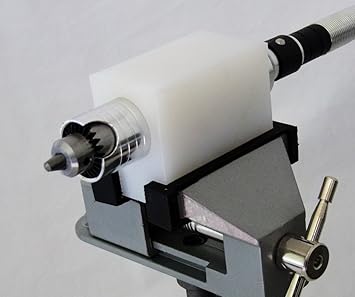Here is a photo of what I was thinking of using. This is probably .010" wire wrapped around .020" wire but I have made some about half this size. The wire inside can move back and forth and go around reasonable bends. If the coiled wire was mounted as the yellow part of your hydraulic cylinder, the wire could be the ram and move the gate. Smaller wire for the core can take tighter bends but won't extend as far before bending. The other end of the coiled wire is mounted solidly up in your loadout and the servo is attached to the core wire to move it.
Another use for this coiled tube is to guide string but obviously it will only be able to pull and another tube and string (or spring) will be required to get the gate to return.
To make the coil, I mounted a small vise to my desk. The vise holds a Foredom #30 handpiece in a nylon holder like this Amazon photo.
A cordless drill in a vise would probably also work. You need good speed control so a Dremel will not work. It also will not have enough torque.
Chuck the core wire into the handpiece. Depending how long of the core you need, holding the other end can be tricky. I made a holder for the other end out of some ball bearings and brass tubing. It has a hook to hold a loop in the end of the core wire and is clamped to the desk with the wire as taut as possible. A lathe with some way to attach the core wire to a live center would work.
The winding wire is held between two blocks of wood. One block has a hole drilled at an angle to let the wire pass through. I put the wire through and leave about 2 inches sticking out. I hold the blocks of wood with parallel jaw pliers or a Kant-twist style clamp. Bend a 90 about 3/4" from the end and slip it into the opening between the jaws of the chuck holding the core wire and slowly start things turning. As the winding wire tightens up, hold the blocks of wood so the winding wire can come out between them and the core wire is perpendicular to that gap. As the core wire turns it will ride against the wood blocks. It should wind the winding wire around the core wire and move along making a neat coil. It does take a little practice and occasionally the winding wire will double back on itself making a coil two layers thick. I just start over then.
Now comes the most dangerous part. Atchung, Notice, Attencion, Peligroso, Farlig, небезпечний , etc. As the end of the winding wire comes out of the wooden blocks it will have about 1.5" straight on the end. Depending on how many times it was wound around the core wire, it will also have some spring to it and unwind several turns at a very rapid pace. If your fingers are in the vicinity, they will start bleeding from multiple cuts, one from each turn. This is the voice of experience, I only let it happen once. Hold the wood blocks with pliers or a clamp and let your fingers have a happy day.
The extreme ends of the tube won't be useful, cut them off with music wire cutters or a cutoff wheel but then you should have a tube you can insert a core into. The tube will be slightly larger than the core you used. There might be some model airplane control cable or bike brake/shifter cable that might work but all I've seen is much larger than what I can make. I hope this made sense, if not ask and I'll try to explain better.



